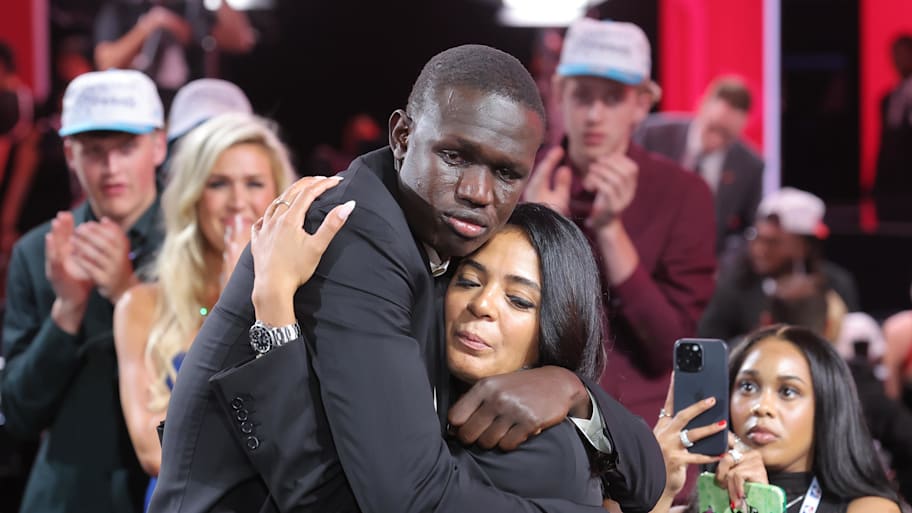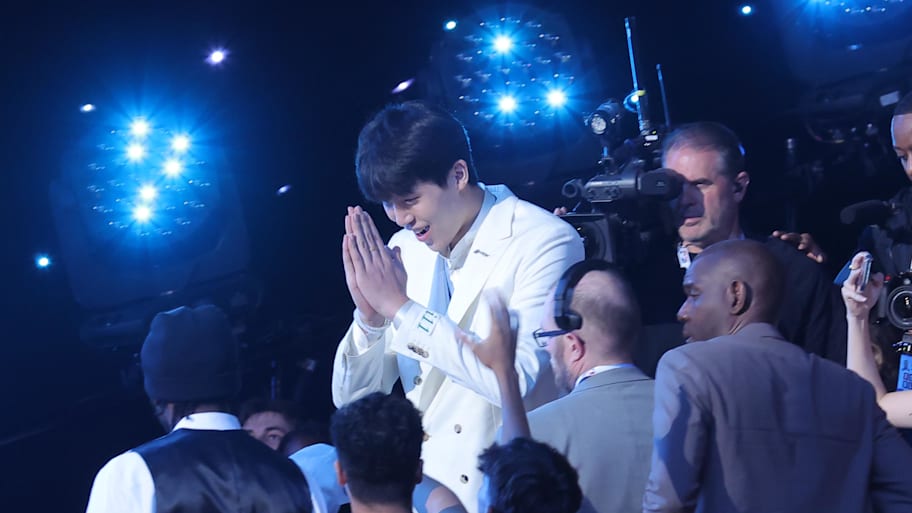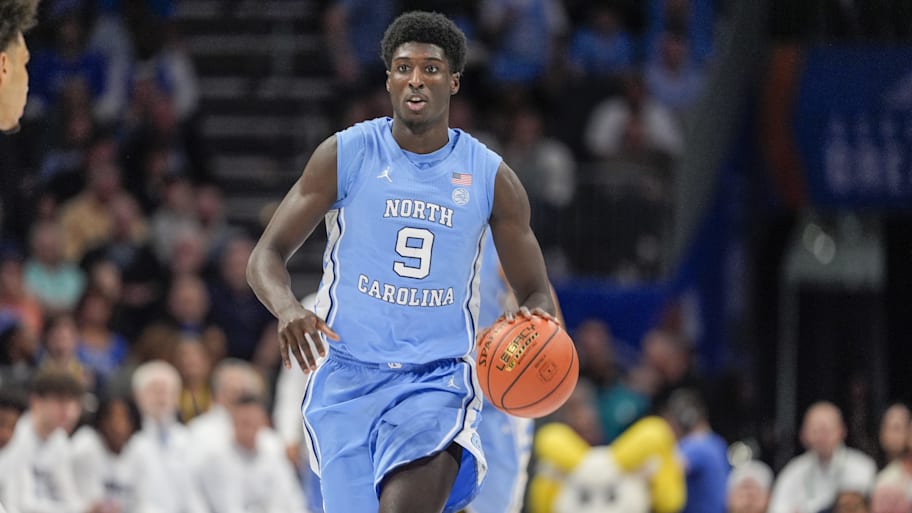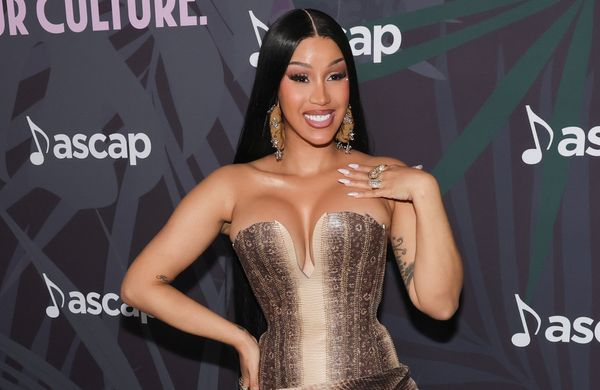
Sports Illustrated is tracking the 2025 NBA draft with grades on every first-round pick. Follow along live as each selection is announced for an instant reaction.
1. Dallas Mavericks: Cooper Flagg, Duke Blue Devils
Grade: A
Flagg never relinquished his stranglehold on the No. 1 spot in this class, dominating at Duke as one of the youngest players in college basketball to separate himself from the field. Landing him gives a Mavericks organization that traded Luka Doncic earlier this year a new face of the franchise. In many ways, you couldn’t pick a better player for where the Mavericks are right now than Flagg, whose defensive intensity and versatility will help Dallas win now while also giving Flagg the time to develop into an offensive alpha once Kyrie Irving and Anthony Davis move on.

2. San Antonio Spurs: Dylan Harper, Rutgers Scarlet Knights
Grade: A
Harper established himself as the clear No. 2 prospect behind Flagg, at times looking like a future offensive engine for a contender in his time at Rutgers. The fit isn’t seamless in San Antonio with De’Aaron Fox and Stephon Castle already in the backcourt, but there’s a world where Harper becomes the best of the bunch and a long-term pick-and-roll partner with Victor Wembanyama. And if nothing else, Harper becomes an asset that the Spurs can package toward a more established star.
3. Philadelphia 76ers: VJ Edgecombe, Baylor Bears
Grade: B+
Edgecombe may not be the highest-ceiling pick on the board, but he’s likely the best fit for a Sixers organization that is still focused on winning and has established pieces around him in Joel Embiid and Tyrese Maxey. He’s an electrifying athlete whose speed and explosiveness should pop even more with NBA floor spacing, and he’s also excellent defensively. He’s someone who can add value early on while still having the upside to emerge into a top option long term.
4. Charlotte Hornets: Kon Knueppel, Duke Blue Devils
Grade: B
After plenty of speculation that this pick could be on the move, Charlotte elected to keep the pick and draft Knueppel, who was essential to Duke’s Final Four run. This is a move to push toward the playoffs, building around a pair of high-usage options in LaMelo Ball and Brandon Miller by adding an elite shooter with great feel for the game in Knueppel. Despite his athletic limitations, many in NBA circles believe he has more upside than just a role-player shooter as he continues to add to his three-level scoring and playmaking arsenal.
5. Utah Jazz: Ace Bailey, Rutgers Scarlet Knights
Grade: A
After plenty of headlines about Bailey’s unorthodox predraft process, the Rutgers product lands at No. 5 in Utah. Bailey’s camp reportedly attempted to position him to land with a team like Washington or Brooklyn, but instead, the Jazz took the dive on a clear top-three talent in this draft despite not getting the chance to work him out prior to draft day. It’s a clear win for Utah to land Bailey after falling on lottery night to No. 5 despite his decision-making warts that have sometimes plagued him throughout his young career. Even if this is a boom-or-bust pick, it’s a risk the Jazz needed to take.

6. Washington Wizards: Tre Johnson, Texas Longhorns
Grade: B-
Bailey not falling to No. 6 left the Wizards forced to pivot to Johnson, a dynamic scorer in his own right who tallied nearly 20 points per game in his lone season at Texas. He may not add the star power Washington hoped to acquire after a miserable season, but after falling to No. 6 during the lottery, landing an elite shooter with some on-ball juice is a solid consolation prize.
7. New Orleans Pelicans: Jeremiah Fears, Oklahoma Sooners
Grade: A
The Pelicans get their point guard of the future in Fears, who was electrifying as an 18-year-old freshman at Oklahoma. While New Orleans doesn’t have a clear direction with its new front office leadership, Fears is such a dynamic ballhandler with the ability to live in the paint, draw fouls and create for others. Consider this a big win for New Orleans.
8. Brooklyn Nets: Egor Demin, BYU Cougars
Grade: C+
The first of five first-rounders for Brooklyn is a surprise in Demin, who lands at the top of his range at No. 8. Demin’s a polarizing player, possessing impressive size and passing ability but lacking physicality and struggling from deep in his lone college season. Long term, the question is whether he ends up as a wing connector with an inconsistent outside shot or if he can emerge as an on-ball threat playing in ball screens. On paper, this looks like a reach.
9. Toronto Raptors: Collin Murray-Boyles, South Carolina Gamecocks
Grade: C
This pick came as something of a surprise after the Raptors were regularly connected to two other frontcourt players in Noa Essengue and Khaman Maluach throughout the process. Instead, they take Murray-Boyles, an analytics darling who turns heads with his defense and feel for the game. He’s someone who doesn’t need the ball in his hands much, but for him to reach his ceiling he’ll need to become a more consistent threat from beyond the arc.
10. Phoenix Suns (via Houston Rockets): Khaman Maluach, Duke Blue Devils
Grade: A
The Suns were one of the worst defenses in the NBA a year ago. Maluach falling to No. 10 gives Phoenix an immediate lift on that end of the floor. He’s still relatively new to the game and scratching the surface of his potential, but he should be able to make an impact early defensively and as a rim-runner on offense as he continues to develop. This is close to a best-case scenario for how to use the pick acquired in the Kevin Durant trade.

11. Memphis Grizzlies (via Portland Trail Blazers): Cedric Coward, Washington State Cougars
Grade: C
Coward was perhaps this draft’s biggest mystery man, having played just six games this season at Washington State before a season-ending shoulder injury. Memphis clearly valued him heavily, moving up five spots to land Coward, who has a highly impressive frame and is a major threat from beyond the arc. This is a reach from where I had him on my board, but he may well have come off the board before No. 16 had Memphis not moved up to get him.
12. Chicago Bulls: Noa Essengue, Ratiopharm Ulm (Germany)
Grade: B+
Essengue’s short slide out of the top 10 ends at No. 12, where Chicago clearly wanted to beef up a frontcourt that’s aging. Essengue isn’t as game-ready as some of the other options on the board for Chicago, but he’s an intriguing long-term option with length, versatility and feel for the game that are hard to find. If he hits, he could become a Pascal Siakam–like player in time.
13. New Orleans Pelicans (via Atlanta Hawks): Derik Queen, Maryland Terrapins
Grade: D
It was no secret around the league that the Pelicans were bullish on Queen, reportedly considering him at No. 7 and now trading up to land him at No. 13. Queen’s a talented prospect, highly skilled on the offensive end. The price to land him is steep though, giving up an unprotected 2026 first-round pick that could well land in the lottery as well as the No. 23 pick in this year’s draft. Plus, the fit between Queen and Zion Williamson isn’t seamless, at least on paper. The pick itself may be a good one, but the cost to get him feels like a very big risk.
14. San Antonio Spurs: Carter Bryant, Arizona Wildcats
Grade: A-
Bryant earned plenty of lottery attention despite averaging fewer than seven points per game last season at Arizona. The fit is strong in San Antonio as perhaps the best 3-and-D prospect in this draft, possessing impressive positional size, defensive versatility and catch-and-shoot ability.
15. Oklahoma City Thunder: Thomas Sorber, Georgetown Hoyas
Grade: B
Oklahoma City elected to stand pat after rumors they could move up, instead taking Sorber, who showed flashes of brilliance as a freshman at Georgetown before a season-ending foot injury. There’s a lot to like here, with a massive wingspan, strong defensive numbers and some feel for the game. The path to minutes in OKC isn’t clear, though his physicality could allow him to earn early playing time.
16. Portland Trail Blazers (via Memphis Grizzlies): Yang Hansen, Qingdao (China)
Grade: D+
This was a legitimate shocker, with Portland taking a projected second-rounder in Yang all the way up at No. 16. Yang was impressive at the NBA draft combine with his size, touch around the rim and passing ability, but questions remain about his mobility and foot speed, especially on defense. Portland did invest significant resources in scouting Yang, so this isn’t out of left field … but from a value standpoint, this isn’t a great pick.

17. Minnesota Timberwolves: Joan Beringer, Cedevita Olimpija (Slovenia)
Grade: B+
The production is still catching up to the potential with Beringer, but for a player as new to the game as Beringer is, the flashes are appealing. He was effective particularly on the defensive end in the Adriatic League and has elite upside on that end of the floor as a rim protector. He’ll get to learn under another French shot blocker in Rudy Gobert.
18. Utah Jazz (via Washington Wizards): Walter Clayton Jr., Florida Gators
Grade: B
Clayton’s rise from high-level football recruit at Iona to winning Final Four Most Outstanding Player at Florida has been remarkable to watch. He’s an elite shooter who proved he could handle full-time point guard duties with the national champions this season and joins a Utah backcourt with plenty of young talent. He’s actually older than Keyonte George and Isaiah Collier, who each got plenty of on-ball reps with the Jazz this season.
19. Brooklyn Nets: Nolan Traore, Saint-Quentin (France)
Grade: B
Brooklyn has invested heavily in international scouting and lands a talented French guard in Traore, who entered the year considered a contender along with Harper for the top spot among point guards in this class. He’s fun to watch with the ball in his hands thanks to his speed and ball-screen prowess. Consistency as a shooter and defender is a concern. I’d have targeted Kasparas Jakucionis if Brooklyn wanted a point guard, but it’s hard to quibble much with this one.
20. Miami Heat: Kasparas Jakucionis, Illinois Fighting Illini
Grade: A
Jakucionis had a fairly wide range entering draft night and ends up falling from the lottery all the way to No. 20, but lands in a fairly good situation in Miami. Miami’s highly competitive environment is a strong fit for Jakucionis, whom Illinois head coach Brad Underwood has raved about for his work ethic. He has drawn comparisons to Austin Reaves and could fit well next to a high-usage scoring guard like Tyler Herro. There could be a path to early minutes here.
21. Washington Wizards (via Utah Jazz): Will Riley, Illinois Fighting Illini
Grade: B+
This was exactly the type of situation you’d expect someone to roll the dice on Riley, a talent-starved organization like Washington with multiple first-round picks. He’s incredibly slender and may never truly beef up his frame much, and he has his flaws defensively. But the offensive package is intriguing, with elite shooting touch, impressive off-ball movement and natural scoring traits. This is a long-term play, but this is a long-term build in progress in Washington.
22. Brooklyn Nets (via Atlanta Hawks): Drake Powell, North Carolina Tar Heels
Grade: C
Powell came into the year with lottery buzz but largely flopped at North Carolina, struggling to find his footing in Chapel Hill, particularly on the offensive end. He’s a freak athlete who can jump out of the gym, but his slow processing speed sometimes neutralizes some of those athletic edges in game action. It seems fairly likely Powell would’ve been available with one of Brooklyn’s later first-rounders, but with five picks the Nets can afford to ‘overdraft’ players they really value.

23. Atlanta Hawks (via New Orleans Pelicans): Asa Newell, Georgia Bulldogs
Grade: B
Newell may have been in play for Atlanta at No. 13 and the Hawks get him anyway at No. 23 after a productive year at Georgia, where he averaged better than 15 points and six rebounds per game. He’s a bit of a tweener, not quite enough of a threat from deep yet to be a true power forward but not physical enough to dominate at the rim as a center. Still, it’s easy to justify this pick for Atlanta, which needed frontcourt help and already added Kristaps Porzingis via trade this week.
Kristaps Porzingis Trade Grades: How Did Celtics, Hawks, Nets Fare?
24. Sacramento Kings (via Oklahoma City Thunder): Nique Clifford, Colorado State Rams
Grade: A-
Oklahoma City didn’t really have room for a second first-rounder on its roster, so shipping out this pick to Sacramento made sense. The Kings get an older plug-and-play piece on the wing in Clifford, who dominated as a fifth-year senior at Colorado State this season. He’s electric as a driver, has strong passing chops and improved his three-point shot at CSU.
25. Orlando Magic: Jase Richardson, Michigan State Spartans
Grade: A-
The Magic seem intent on contending after trading four future picks for Desmond Bane and continue to add offensive firepower with Richardson, who was hyper-efficient at Michigan State this season. His NBA fit isn’t seamless because of his lack of size, but he makes sense on an Orlando roster that has tons of positional size and defensive versatility in the backcourt to insulate him with Jalen Suggs and Anthony Black.
26. Brooklyn Nets: Ben Saraf, Ratiopharm Ulm (Germany)
Grade: B
Saraf has long made sense as a potential Brooklyn target. Considered a fringe first-rounder entering the draft, Saraf has excellent size for a combo guard and is fun to watch in ball screens. He’s also on the younger side and is someone Brooklyn can continue to bring along as it attempts to rebuild its roster.
27. Brooklyn Nets: Danny Wolf, Michigan Wolverines
Grade: A-
The Nets somewhat surprisingly made all five first-round picks, rounding out a massive class with Wolf, perhaps the most unique player in this draft. He’s a jumbo 7-foot ballhandler that can really pass and has a crafty offensive game. He likely won’t get the same freedom in the NBA as he did in college, but Brooklyn clearly valued his size and feel for the game.
28. Boston Celtics: Hugo Gonzalez, Real Madrid (Spain)
Grade: A-
Gonzalez saw his stock fall throughout the year after failing to secure consistent playing time at Real Madrid, but a year ago at this time he was considered perhaps the best international player in this class. His motor is elite, as is his versatility on the defensive end. This is a strong buy-low bet for a Celtics team looking for value on affordable contracts.
29. Charlotte Hornets (via Phoenix Suns): Liam McNeeley, UConn Huskies
Grade: A
The fourth Montverde Academy product picked in this first round, McNeeley finally heard his name called at No. 29 after a bit of a draft night slide. In McNeeley and Kon Knueppel, Charlotte has added a pair of high-level shooters who’ve been lauded as two of the most competitive players in this draft. They should up the intensity level in Charlotte from Day 1.
30. Los Angeles Clippers: Yanic Konan Niederhauser, Penn State Nittany Lions
Grade: B
Niederhauser played his way from the G League Elite Camp into the combine and now into first-round pick status, landing in Los Angeles where the Clippers were known to be hunting a game-ready frontcourt player. He has elite physical tools and put it all together this year at Penn State after playing a smaller role at Northern Illinois in his first two years of college. He’ll have to prove he can handle the physicality of NBA centers to earn early minutes, but his upside is higher than most of the other bigs in this range.
More NBA draft on Sports Illustrated
This article was originally published on www.si.com as NBA Draft First-Round Grades: Every Selection From Cooper Flagg to No. 30.







